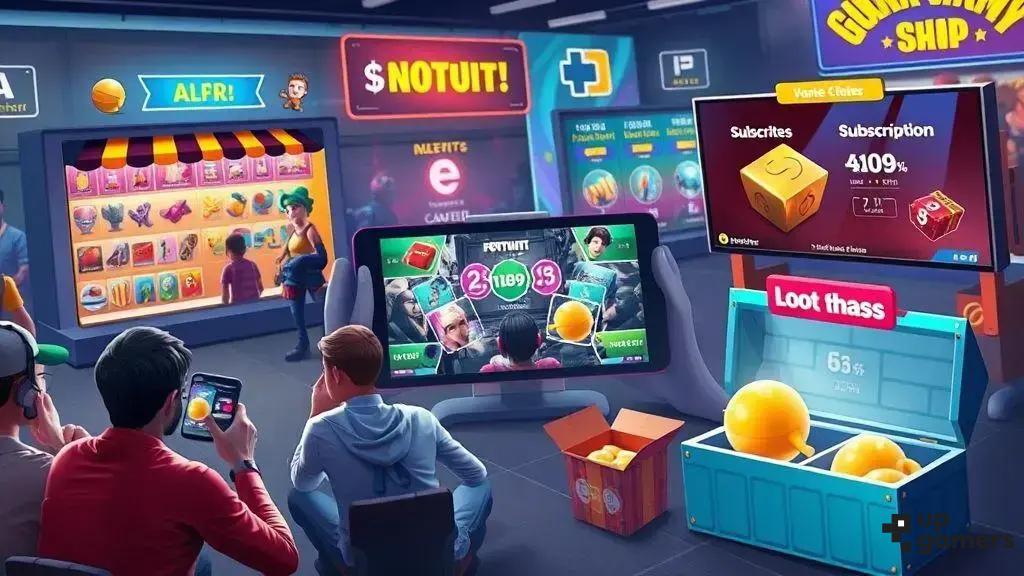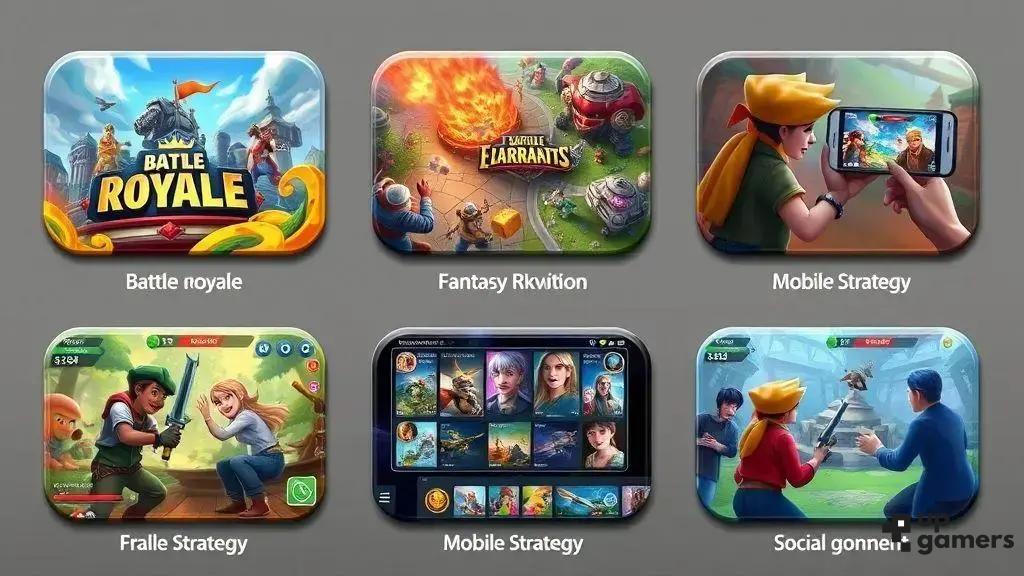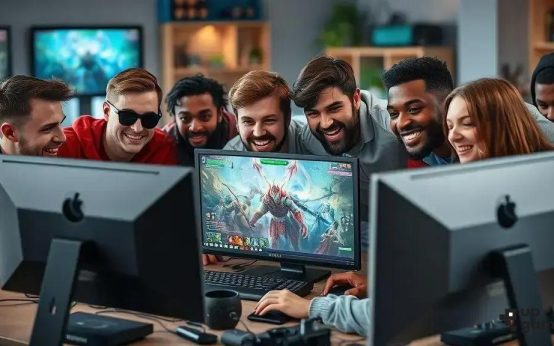How game developers monetize free-to-play games involves using in-game purchases, ads, subscriptions, and event sales while balancing fair player experience and evolving with trends like personalized offers and blockchain technology.
How game developers monetize free-to-play games is a fascinating blend of art and strategy. Ever wondered how games you play for free can turn into profitable ventures? Let’s explore the key methods behind this business model.
understanding the free-to-play model
The free-to-play model is a popular approach in the gaming industry, allowing users to download and play games at no initial cost. Instead of charging upfront, developers focus on attracting a large player base by offering free access, making gaming more inclusive.
Games using this model often rely on optional purchases or advertisements to generate revenue, so understanding how these elements fit together is crucial. This strategy lowers the barrier for new players and encourages long-term engagement.
Core Features of Free-to-Play Games
Most free-to-play games offer a wide variety of content for players to enjoy without payment. However, they also include in-game items, cosmetic upgrades, or power-ups that enhance the experience for users willing to spend money.
The model embraces a balance between generosity and monetization, where players can choose how much to invest in the game, if at all. This flexibility has contributed to the widespread popularity and longevity of many games worldwide.
Player Acquisition and Retention
Free access draws players quickly, but keeping them engaged is essential for revenue growth. Developers use events, regular updates, and social features to build communities and encourage daily play. The larger and more active the player base, the greater the opportunities for monetization.
Understanding these dynamics helps explain why free-to-play games are dominant in mobile and online platforms today.
common monetization strategies

There are several common monetization strategies that game developers use to generate income from free-to-play games. These methods aim to balance player enjoyment while encouraging spending.
In-Game Purchases
Also known as microtransactions, in-game purchases allow players to buy virtual items such as skins, weapons, or currency. These purchases enhance the gameplay without blocking progress, making them appealing to both free and paying users.
Advertisements
Many free-to-play games include optional ads that players can watch to earn rewards like extra lives or game currency. Banner ads and interstitials are also common. This strategy earns money while keeping the base game free.
Subscriptions
Some games offer subscription plans that provide exclusive content, faster progress, or in-game bonuses. Subscriptions create steady revenue and can deepen player loyalty.
Loot Boxes and Gacha Mechanics
These randomized rewards offer players a chance to win rare items. Though controversial, when implemented fairly, they add excitement and can drive spending.
Season Passes and Event Sales
Timed events and season passes provide exclusive challenges and rewards for a limited period. Players often pay for access, which drives engagement and revenue.
Understanding these strategies helps players see how free games stay profitable while offering fun and ongoing content.
balancing player experience and revenue
One of the biggest challenges for developers is balancing player experience and revenue. While monetization is essential, players must feel the game remains fun and fair.
Fair Play and Avoiding Pay-to-Win
Players expect that spending money should enhance their experience without ruining competition. Developers often avoid pay-to-win models because they can alienate non-paying users. Instead, they focus on cosmetics and optional upgrades.
Transparent Monetization
Clear communication about what players get for their money builds trust. When players understand the value of purchases, they’re more likely to spend voluntarily.
Rewarding Engagement
Many games use rewards for regular play, such as daily bonuses or challenges. This keeps players coming back while encouraging natural spending through progression.
Limiting Ads and Intrusive Offers
While ads can bring income, too many can frustrate users. Successful games find ways to show ads without disrupting gameplay, often making ads optional and rewarding.
Good balance means players enjoy the game and developers sustain a profitable business over time.
examples of successful free-to-play games

Many games have successfully used the free-to-play model to become popular worldwide and generate significant revenue. These examples showcase various strategies and styles that appeal to millions.
Fortnite
Fortnite is a prime example of how cosmetic microtransactions and seasonal events create massive revenue streams. Players enjoy free access while purchasing skins and passes that do not affect gameplay balance.
League of Legends
This game combines free character play with paid options for faster unlocking and cosmetic upgrades. Its strong esports presence keeps players engaged and supports continuous updates.
Clash of Clans
A mobile favorite that uses in-game currency purchases and timed events. Its social and competitive features encourage players to invest in upgrades to progress faster.
Genshin Impact
Known for its gacha mechanics, Genshin Impact offers stunning visuals and story-based content. Players can enjoy much for free but can choose to spend on randomized rewards.
Among Us
This social deduction game became a hit with free access and optional purchases for skins and pets. Its simple monetization didn’t affect the core gameplay experience.
These examples prove that free-to-play games can thrive by offering value and player choice.
challenges and future trends in monetization
Monetizing free-to-play games comes with unique challenges that developers must navigate to succeed. One major hurdle is maintaining player trust while encouraging spending. Aggressive tactics can lead to frustration and player loss.
Combatting Player Fatigue
Players may grow tired of constant ads, microtransactions, or repetitive events. Developers need to innovate and keep content fresh to sustain interest and revenue.
Regulatory Concerns
Governments around the world are increasingly scrutinizing loot boxes and gambling-like features. This raises the need for transparent monetization and compliance with evolving laws.
Balancing Fairness and Profit
Ensuring that monetization doesn’t create a pay-to-win environment is critical for long-term community health. Games that are seen as fair enjoy better retention and reputation.
Future Trends
We expect to see more personalized monetization using data analytics to target offers better. Subscription services and cross-platform integration will also grow, providing steady income and wider reach.
Innovations like blockchain and NFTs could reshape monetization, offering new ways to own and trade digital assets within games.
Wrapping up monetization in free-to-play games
Monetizing free-to-play games requires careful balance between making money and keeping players happy. Developers must use fair strategies that enhance the gaming experience without feeling forced or unfair.
By understanding common methods, player needs, and future trends, developers can create games that thrive financially while building loyal communities. As the industry evolves, innovation and transparency will be key to success.
Players benefit from games that offer choice and value, making the free-to-play model a winning formula for everyone involved.
FAQ – How game developers monetize free-to-play games
What is the free-to-play model in gaming?
The free-to-play model allows players to access and play games for free while offering optional purchases and ads for revenue.
How do in-game purchases work?
Players can buy virtual items like skins, upgrades, or currency to enhance their experience without mandatory payments.
What role do advertisements play in monetization?
Ads provide revenue by offering players rewards for watching them or displaying non-intrusive ads during gameplay.
How do developers balance monetization and player experience?
By focusing on fair, transparent monetization methods that do not hinder gameplay or create pay-to-win situations.
What are some challenges in monetizing free-to-play games?
Challenges include avoiding player fatigue, complying with regulations, and maintaining trust while encouraging spending.
What future trends may impact free-to-play game monetization?
Personalized offers, subscription models, cross-platform play, and technologies like blockchain and NFTs could shape the future of monetization.




